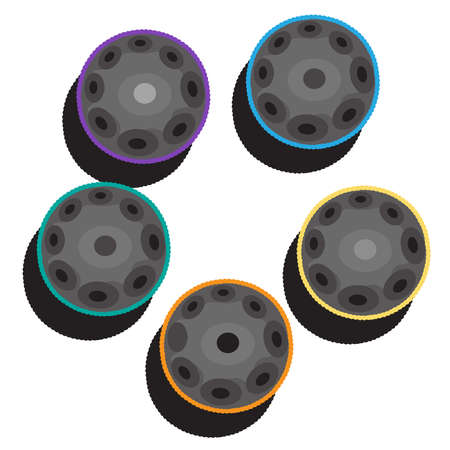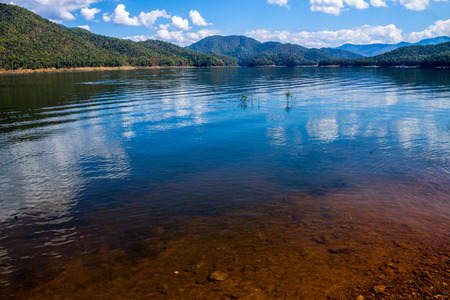Introduction: The Lure of Hidden Bass Havens
When it comes to chasing monster bass, most anglers immediately think of legendary lakes like Lake Fork in Texas or Florida’s Okeechobee. These famous hotspots have earned their reputations for good reason, attracting crowds of passionate fishermen and plenty of media attention. However, the very popularity that makes these destinations iconic can also work against you—crowded ramps, pressured fish, and a competitive atmosphere often make landing a true trophy bass more challenging than you’d expect. That’s where America’s hidden gems come into play. Lesser-known lakes across the U.S. offer untouched waters, lighter fishing pressure, and the kind of solitude that lets both you and the fish settle in. These underrated fisheries can quietly harbor giant bass just waiting for someone willing to look off the beaten path. In this article, we’ll explore why these unheralded locations are worth your attention and how they stack up against the nation’s most celebrated bass lakes.
2. What Makes a Great Bass Lake: Key Characteristics
When searching for hidden gems that hold monster bass, it’s crucial to understand what sets these lakes apart from the typical fishing spots. Not all waters are created equal—some offer the perfect blend of environmental conditions that let bass grow big and thrive. Let’s break down the core elements that make certain underrated U.S. lakes prime territory for trophy bass.
Water Quality: The Foundation for Healthy Bass
Bass need clean, oxygen-rich water to reach their full potential. Lakes with stable water temperatures, adequate dissolved oxygen, and minimal pollution provide a healthier habitat for both bass and their prey. Clear water isn’t always best—some stained or slightly murky lakes actually support larger bass due to more abundant cover and reduced fishing pressure.
Key Water Quality Factors
| Factor | Why It Matters |
|---|---|
| Dissolved Oxygen | Bass require at least 5 mg/L; higher levels support growth and activity. |
| Temperature Stability | Stable temps (60–80°F) reduce stress and extend feeding periods. |
| Water Clarity | Moderate clarity offers optimal ambush conditions and protection from predators (including anglers). |
Forage Availability: Fuel for Giants
A lake loaded with diverse forage like shad, bluegill, crawfish, and even stocked trout can turn average bass into certified monsters. It’s not just about quantity—variety matters too, letting bass grow faster by switching between food sources as seasons change.
Common Forage Species in Hidden Gem Lakes
| Forage Type | Bass Growth Benefit |
|---|---|
| Threadfin/Shad | High-protein; supports rapid weight gain |
| Bluegill/Sunfish | Abundant and available year-round |
| Crawfish | Packed with nutrients during spawn seasons |
Fishing Pressure: The Secret Sauce
Lakes off the beaten path often get overlooked by most anglers, giving bass a chance to grow without constant harassment. Less fishing pressure means older fish, bigger sizes, and unique opportunities for those willing to explore beyond the well-known hotspots. Many hidden gems are on smaller public reservoirs or private waters with restricted access—but if you can find a way in, you’re likely to find less-pressured giants lurking beneath the surface.

3. Underrated Lakes Worth the Trip
If you’re on the hunt for monster bass, sometimes it pays to skip the usual hotspots and explore lakes that fly under the radar. Across the U.S., there are hidden gems where savvy anglers quietly haul in impressive catches without the crowds or hype. Here’s a closer look at some underrated lakes from different regions that consistently produce trophy-sized largemouths.
Lake Nacogdoches, Texas
While Texas is famous for giants like Lake Fork, Lake Nacogdoches is a lesser-known standout in East Texas. Despite its modest size, this reservoir produces double-digit bass thanks to strict slot limits and healthy forage populations. Local insiders know spring and early summer are prime times to target brush piles and submerged timber for big bites.
Lake Okhissa, Mississippi
Nestled within the Homochitto National Forest, Lake Okhissa rarely makes national headlines but remains a favorite among Southeast locals chasing quality fish. The lake’s deep, clear waters and abundant structure make it ideal for both power fishing and finesse presentations. Anglers report regular encounters with 7- to 10-pound largemouths—especially during pre-spawn.
Upper Otay Reservoir, California
Southern California’s Upper Otay is a historic fishery with a reputation for producing huge bass, yet it flies under most anglers’ radars due to limited access and strict regulations. The lake is managed as a trophy bass water, and catch-and-release practices ensure there are always giants lurking beneath the surface. Dedicated West Coast anglers swear by swimbaits and topwater lures here for heart-stopping strikes.
Lake St. Clair Metropark Ponds, Michigan
While Lake St. Clair itself is well known, the surrounding Metropark ponds offer surprising largemouth opportunities in the Midwest. These small waters don’t get much pressure but hold healthy populations of chunky bass—perfect for kayak or bank anglers looking for solitude along with solid action.
Lake Moomaw, Virginia
Tucked away in the Allegheny Mountains, Lake Moomaw is an Appalachian treasure. Its remote location means light fishing pressure, allowing bass to reach impressive sizes. Rocky shorelines, flooded timber, and aquatic vegetation create perfect ambush spots for trophy fish throughout the seasons.
Why These Lakes Matter
These underrated lakes prove that you don’t need to follow the crowds to land your personal best. With a little research and willingness to venture off the beaten path, anglers can discover new favorite spots—and maybe even keep a few secrets of their own.
4. Pro Tips: Gearing Up for Hidden Gems
When it comes to chasing monster bass in underrated, low-pressure lakes, the right gear can make all the difference. These fisheries often have unique characteristics, so your tackle and techniques should be tailored for stealth, versatility, and power. Here’s a breakdown to help you maximize your shot at a personal best.
Tackle Selection: Go Heavy, But Stay Stealthy
Most hidden gems feature thick cover—think submerged timber, grass mats, or rocky outcrops—where big bass love to ambush prey. Here’s a quick reference guide:
| Rod | Reel | Line | Why It Works |
|---|---|---|---|
| 7’+ Medium-Heavy to Heavy Fast Action | Baitcasting (6.3:1–8.1:1) | Braided (40–65 lb) or Fluorocarbon (15–20 lb) | Power for hooksets & control; sensitive for finesse bites |
Lure Choices: Match the Forage, Trigger Big Strikes
Underrated lakes often see less pressure, so bass might not be lure-shy—but they’re still keyed into local forage. Here are some proven options:
- Swimbaits: Large soft-plastic swimbaits imitate gizzard shad or bluegill. Go big—a 6-8” bait isn’t too much for giants.
- Punch Rigs: Perfect for matted vegetation; use a heavy tungsten weight with a creature bait to punch through cover.
- Jigs: Black/blue or green pumpkin flipping jigs with a trailer mimic crawfish and work wonders around structure.
- Topwater Frogs: Early morning or cloudy days, skip frogs over lily pads or grass beds for explosive bites.
- Senkos/Wacky Worms: Subtle presentations excel when bass are pressured or inactive—weightless rigs work well in clear water.
Techniques: Adaptability Wins on Unknown Water
The best anglers adjust quickly to changing conditions and unexplored habitats. Consider these tactics:
- Cover Water Efficiently: Start with reaction baits like spinnerbaits or chatterbaits to locate active fish, then slow down with plastics once you find them.
- Stay Quiet: Use stealth approaches—turn off electronics in shallow water, minimize boat noise, and cast from a distance to avoid spooking wary bass.
- Fish the “No-Man’s-Land”: In less-pressured lakes, don’t ignore mid-depth flats or isolated cover that others might overlook.
- Tune Your Presentation: If bites are short or missed, downsize your lure or switch colors until you dial in what triggers strikes.
Your Hidden Gem Checklist
| Tactic | Benefit | Best Application |
|---|---|---|
| Punching Mats | Reaches hidden giants in thick vegetation | Matted grass or hydrilla beds |
| Casting Swimbaits Deep | Mimics large prey in open water; targets suspended fish | Main lake points & creek channels |
| Skipping Jigs Under Docks/Trees | Presents bait where big bass hide from pressure and sun | Docks, laydowns, overhanging brush |
The Bottom Line: Preparedness Meets Opportunity
The magic of hidden gem lakes is that every cast could connect you with the fish of a lifetime. Bring versatile gear, adapt your tactics on the fly, and focus on precision rather than covering endless water. In America’s overlooked waters, fortune favors the prepared angler—and that next monster bass could be waiting just around the bend.
5. Respecting the Resource: Conservation and Local Etiquette
When exploring underrated lakes for monster bass, its crucial to remember that these hidden gems depend on us for their preservation. Practicing sustainable fishing is more than a suggestion—its a responsibility. Always familiarize yourself with local regulations such as bag limits, size restrictions, and seasonal closures. Most states require anglers to have a valid fishing license, so check the requirements before casting out. Catch and release is highly encouraged in less-pressured lakes to ensure future generations can experience the same thrill of landing trophy bass. Use barbless hooks when possible, handle fish gently, and return them quickly to minimize stress. Respect private property by only accessing launch points and banks where permitted, and always leave no trace—pack out your trash and avoid disturbing wildlife. Remember, locals often rely on these waters for their own recreation or livelihood, so be courteous and willing to share space. A simple wave or friendly conversation goes a long way in maintaining good relationships with the community. By showing appreciation for these special places through responsible actions, we help keep Americas secret bass hotspots thriving for years to come.
6. Making the Most of Your Trip
To truly enjoy these underrated lakes for monster bass, planning ahead is key.
Best Seasons to Fish
While some lakes offer year-round action, spring and early summer are generally prime times for big bass across the U.S. This is when the fish are most active due to spawning and warmer water temperatures. Fall can also bring excellent results as bass feed aggressively before winter. Always check local regulations—some hidden gems may have seasonal restrictions or special catch-and-release rules.
Local Amenities and Accommodations
Many of these lesser-known lakes are tucked away in rural or small-town America. You’ll often find charming mom-and-pop motels, rustic cabins, and locally owned diners nearby. It’s a good idea to call ahead for lodging, especially during peak fishing months or local festivals. Don’t overlook bait shops—they’re not only great for picking up the right tackle but also for getting the latest insider tips from locals.
Blending into the Local Scene
If you want to be welcomed at the boat ramp or the corner store, respect local customs and property. Keep noise down in early mornings, pack out your trash, and be courteous at public docks. Strike up a conversation with fellow anglers or shop owners—you might get pointed toward an untapped cove or learn about a weekend fish fry. Supporting local businesses goes a long way; grab breakfast at the diner or buy your supplies locally instead of bringing everything from home.
Quick Tips for a Seamless Trip
- Carry cash for small-town shops that may not accept cards.
- Check weather forecasts and pack appropriate gear—it can be unpredictable near remote lakes.
- Download offline maps; cell service can be spotty in hidden gem locations.
Final Thoughts
With a little preparation and an open mind, these underrated lakes can offer some of the best monster bass fishing—and memories—you’ll ever have. Respect the places you visit, connect with the community, and you’ll find yourself welcomed back year after year.


